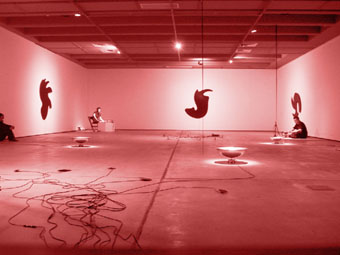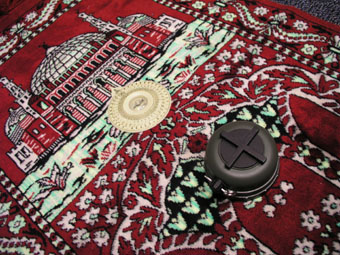Seeds, particles, resonances
Keith Gallasch

Ed Osborn & Elision, Particle Moves 2003
photo courtesy Institute of Modern Art
In installations by Ed Osborn (Germany) and Nigel Helyer (Australia) in Brisbane and Sydney respectively, I spend most of the time staring at the floor. And listening. Especially listening. In both works suspect objects litter gallery floors. In Osborn’s Particle Moves, clusters of tiny metal disks, appearing to hover just over the sheen of the concrete floor, suddenly buzz and rattle to life and move short distances like wary robotic insects. In Helyer’s Seed, the objects are overtly worrisome, they’re landmines neatly positioned on the centre of a series of eastern prayer mats. But they’re also transmitters and as you approach them you pick up the sounds they emit in the earphones (which you collected when you left your shoes outside) via the handset you carry, replicated to look like a mine detector. Elsewhere on the floorspace of Particle Moves sound drivers vibrate wok-shaped bowls and long wavering rods; on the walls elegant elliptical black metal cut-outs a la Matisse are just as driven, quietly humming or crackling or thundering between protracted silences. As you come within range of each of the “mines” in Seed you detect not a warning, but the 99 names of Allah, looped Arabic music and extracts read from the Koran.

Nigel Helyer, Seed
At one level Seed is curiously meditative; you journey from one mine to another, from one passage of the Koran to the next, you learn, you take in the details of the mats, the insistent rhythms of the music. On another level it is alarming, associations turn between agriculture and war, between the seeds of life and the seeds of death. Helyer writes: “…the death toll inflicted by landmines (principally in the developing world) is equivalent to the appalling destruction of the World Trade Centre—repeated 5 times each year.” Other resonances accumulate in Helyer’s “sonic minefield” to do with our incomprehension of the Islamic faith and culture and what the West will reap from this ignorance.
Osborn’s work is urbane and abstract, but its irregular beauty is made from the fundaments of sound—the movement of particles. It too has much to do with resonance, the loud speaker/sound driver as an instrument engaging with other, musical instruments, the outcomes accumulating in a computer. So although there’s not much room here for metaphor (beyond the distant connotations offered by wok and rod), there is the sense of something unnameable, larger than the gathering of objects in a gallery space, because the objects are linked by sound, because they are growing something sonic and uttering it, it seems, whenever they like. The seeds for this creation were partly sown by members of the Elision ensemble in improvised live performance with Osborn recording them, feeding their sounds into the installation where they became something else. A week later I had the space to myself, but not really. The room rattled and sighed and sang and wailed and went silent and I waited and it sang again.
Seed and Particle Movement confirm in their very different ways the power of expertly realised sound installations to fascinate and disturb, to take you deep into and through sound into rewritten, re-sounded worlds.
Particle Moves, Ed Osborn, IMA, Fortitude Valley, Brisbane, July 31-Aug 30; Nigel Helyer, Gone to Earth: Seed and Haiku, Boutwell Draper Gallery, Redfern, Sydney, Sept 10-Oct 4
RealTime issue #58 Dec-Jan 2003 pg. 46






